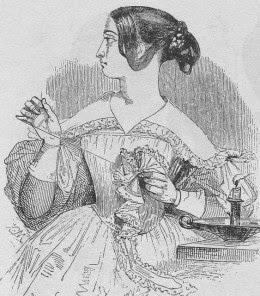Victorian Hairstyles
'A women's crowning glory' - This is an expression relating back to the Victorian period, women's hair was usually styled and badly damaged due to the use of hot iron to produce a curl rather than a crimp. This lead victorian women having to overlay the unpleasant scent of burnt hair with perfume. Typical women of this era had hair at a wool- like texture. The hair was only cut due to serious illness.
Hair for the average face included graceful waves, coquettish curls and plaits of hair arranged to create a unique interesting piece. The hair was often braided and twisted and arranged to either create height or to help make the shape of the face appear oval or round. Curly hair was to indicate a sweet, kind temperament however strait hair was considered much more reserved or awkward. Within undo's the hair was often lifted up however when the hair was down their was often a smooth, slick centre parting commonly worn in the 1870's.
Barely or sugar curls, 1843 - This hairstyle was based on making tight curls with long hair. the style was created by using hot irons to cripple the hair. This style was seen to be very elegant, feminine and glamorous as helped to frame the face. Later on in the 19th century women began to adapt and experiment with the curls typically leaving one or two ringlets down the side of their face.
These were often seen worn by children with ribbon and lace secured designed to match their dresses.
Crimping, 1872 - As the use of hot irons was growing in popularity during the victorian era, many women were experimenting with crimping. this lead to many crimped updo's. Accessories made a huge difference when it came to the crimping style as the hairstyle looked very elegant and glamorous when braids, flowers, strings, beads, lace and ribbons were added. Many women would also crimp their fringe leaving a short curly fringe framing the face making several appearances in Victorian era portraits.
Pompadours, 1880's - Pompadours were worn by the end of the 1880's. This is where the hair is lifted up from the forehead. Many would add height and volume by adding padding or fake pieces of hair. Full pompadours were worn on special occasions however low pompadours worn daily as it was much more casual. Hats were also worn with this hairstyle held in place by long hatpins. As time went on and progressed the trim on the hat decreased as brim increased.
Braids - Early in the victorian era braids were worn by most women with long strait hair. The hair was often pulled into a pony with braids that include 1, 3, or 5 section braids, each section braided individually. Many victorian undoes were complimented with braids as either a finishing element or a flourish. Within the link below i have found a tutorial of a victorian era hairstyle including a three strand braid created by many women in this era.
https://www.youtube.com/watch?v=7N7_7_NlnF0
Chignon - Chignons hairstyles are formed by pinning the hair low into a knot at the back of the head. Chignons were extremely popular during the victorian era with people adding false hair or padding to create height and volume. Chignons are traditionally placed at the nape of the neck however can be positioned in any area of the head. Chignons can also be positioned anywhere on the head from a few inches from the hairline to the middle of the back of the head between the crown and nape of neck.
The Gibson girl, 1890's to early 1990's - This style was known as the century first pin up created by illustrator Charles Dana Gibson in 1902 to represent the image of an ideal women. The Gibson girl consisted of a soft pompadour puffed up to add height, volume and a cloud effect. The gibson girl is a loose soft bun which represented and an independent, sporty and simple type of women with the hairstyles loose and care-free not like many of the victorian era updo's. This hairstyle is effortless, simple and graceful.
In conclusion, as time progressed so did the styles. Women began to experiment with hot irons, curling techniques, undo's and braids. Curls were created and women's hair became much more individual and unique. The hair became much bigger and volumous to make women much more feminine and elegant. This era was considered by many one of the most contributed era in the fashion and beauty industry for both women and men. Many say this era contributed and opened many doors to both industries.
List of websites used - http://www.1920-30.com/fashion/hairstyles/marcel-wave.html
http://www.hairarchives.com/private/victorian1new.htm
http://www.crystalinks.com/hair.history.html
http://slodive.com/inspiration/victorian-hairstyles/
http://www.stylisheve.com/glamorous-victorian-hairstyles-for-women/
http://www.crystalinks.com/hair.history.html
http://slodive.com/inspiration/victorian-hairstyles/
https://pntheatre.wordpress.com/2012/11/10/diy-victorian-hairstyles-inspired-by-a-little-night-music/











No comments:
Post a Comment